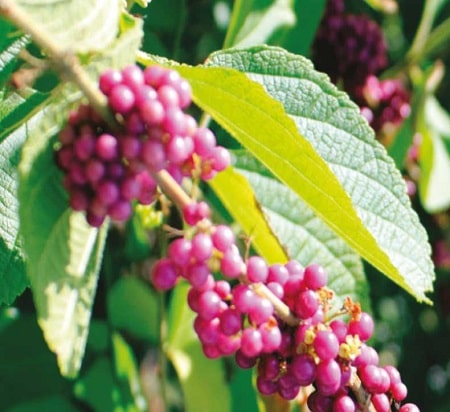Callicarpa bodinieri ‘Profusion’ is the botanical name for a specific variety of beautyberry plant. Beautyberry is a deciduous shrub known for its attractive clusters of bright purple to violet berries that appear in the fall, making it a popular ornamental plant in gardens and landscapes. Callicarpa bodinieri ‘Profusion’ is a cultivated cultivar of beautyberry, and it is valued for its particularly abundant and vibrant berry production. In English, it is commonly referred to as “Profusion Beautyberry” or simply “Profusion.”
It’s important to note that while Callicarpa bodinieri ‘Profusion’ can thrive in a range of climates, it may have specific soil and sun requirements. It generally prefers well-draining soil and can tolerate full sun to partial shade. Before planting ‘Profusion’ or any other plant, it’s a good practice to consult with local gardening experts or nurseries to ensure that it is well-suited to your specific location and conditions. This will help you make the most of this beautiful and ornamental shrub in your garden.
Callicarpa bodinieri ‘Profusion’
Callicarpa bodinieri var. giraldii, commonly known as Beautyberry Profusion, is a beautiful shrub known for its striking purple berries in the fall. To care for this plant, you can follow these guidelines:

- Planting:
- Select a location with well-draining soil that receives full to partial sun. Callicarpa prefers sunny spots but can tolerate some shade.
- Watering:
- Keep the soil consistently moist but not waterlogged, especially during the growing season. Regular watering is essential, particularly during dry periods.
- Pruning:
- Prune your Beautyberry Profusion in late winter or early spring to maintain its shape and remove any dead or damaged branches. This will encourage healthy growth and berry production.
- Fertilizing:
- You can apply a balanced, slow-release fertilizer in the spring to provide essential nutrients for the plant’s growth.
- Mulching:
- Apply a layer of mulch around the base of the plant to help retain soil moisture and suppress weeds.
- Winter Protection:
- In colder regions, consider adding a layer of mulch or straw around the base of the plant to help protect it from freezing temperatures.
- Pests and Diseases:
- Beautyberry Profusion is generally resistant to most pests and diseases. However, you should monitor your plant for any signs of issues and address them promptly if they arise.
As for your question about purple berries in England, there are several plant species that produce purple berries in England. Some of them include:
- Sloe (Prunus spinosa): Sloe berries are small, dark purple, and are used to make sloe gin.
- Elderberry (Sambucus nigra): Elderberries are small, dark purple to black berries and are often used to make elderberry syrup or wine.
- Blackthorn (Prunus spinosa): Blackthorn berries are dark purple and are used to make sloe gin.
- Bilberry (Vaccinium myrtillus): Bilberries are similar to blueberries but are smaller and darker in color. They can be found in forests and are often used in pies and jams.
- Blackcurrant (Ribes nigrum): Blackcurrants produce small, dark purple to black berries used for making jams, jellies, and desserts.
These are just a few examples of plants with purple berries that you might find in England. When foraging for berries in the wild, always ensure that you can correctly identify the plant and that the berries are safe to consume, as not all purple berries are edible.
Where does Profusion (Callicarpa bodinieri) grow?
Callicarpa bodinieri ‘Profusion’ is a cultivar of Beautyberry (Callicarpa bodinieri) and is primarily grown in temperate regions. It is suitable for hardiness zones 5 to 8 in the United States, which means it can thrive in a range of climates. Here’s a general idea of where Callicarpa bodinieri ‘Profusion’ can grow:
- United States: ‘Profusion’ can be successfully cultivated in a variety of states across the United States, particularly in regions with temperate climates. It is well-suited to zones 5 through 8, which includes states in the eastern and central parts of the country.
- Europe: Beautyberry is grown in many parts of Europe with suitable climates. ‘Profusion’ can be found in gardens and landscapes in countries across Europe, particularly in regions with a mild to moderate climate.
- Asia: Beautyberry, including ‘Profusion,’ is native to China and is also cultivated in other parts of Asia. It can be found in gardens and landscapes in regions with climates similar to its native habitat.
- Other Regions: In addition to the above-mentioned areas, ‘Profusion’ may be cultivated in other temperate regions worldwide where the climate is conducive to its growth.
Is Profusion (Callicarpa bodinieri) fruit edible?
The fruit of Callicarpa bodinieri ‘Profusion,’ like other varieties of Beautyberry (Callicarpa), is generally considered non-toxic but is not typically consumed as it is not particularly palatable. The small, bright purple berries of ‘Profusion’ are often grown for their ornamental value, as they provide a burst of color in the garden and are attractive to birds, but they are not typically used for human consumption.
The taste of Beautyberry berries is described as mildly bitter and astringent, and they are not commonly used in culinary applications. While the berries are not known to be toxic, it’s best to avoid consuming them, as there are more appealing and edible berries and fruits available for consumption in gardens and the wild.
If you are interested in growing edible berries in your garden, there are many other fruit-bearing plants and shrubs that are more suitable for this purpose. Always be sure to positively identify any plant before consuming its fruit and consult with local experts or resources on the edibility of specific plants in your area.
